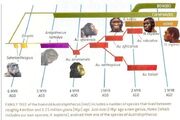
The fossil record has revealed evidence of human evolution. Fossils allow scientists to analyze how body size/structure, brain size, diet, and locomotion has changed over the past 6 million years. Radiometric dating makes determining the age of early human remains possible.

Finding Lucy
Video about finding Lucy (a Australopithecus afarensis fossil).
Ardipithecus and Australopithecus Group[]
The Ardipithecus group of early humans is our closest connection to primates. They took the first step to walk upright as they evolved in Africa 4.5 to 7 million years ago. This group includes Sahelanthropus tchadensis , Orrorin tugenensis, Ardipithecus kadabba , and Ardipithecus ramidus. The Australopithecus group had human-like and ape-like characteristics. They lived in Africa 2 to 4 million years ago. They walked in a bipedal fashion on a regular basis, yet also climbed trees. This group includes Australopithecus anamensis, Australopithecus afarensis, Australopithecus garhi, and Australopithecus africanus.
Paranthropus and Homo Group[]
The Paranthropus group were able to diversify their diets and eat many foods. They are distinctive for their strong jaws and teeth that allowed them to grind food. This group that thrived1.2 to 2.7 million years ago included Paranthropus aethiopicus, Paranthropus robustus, and, Paranthropus boisei. The Homo group, along with modern day Homo sapiens, are known for their larger brains and ability to create and use tools. This group contains species that were the first to expand out of Africa. They lived from 2.4 million years ago to present day. Group members include Homo rudolfensis, Homo habilis, Homo erectus, Homo heidelbergensis, Homo floresiensis, Homo neanderthalensis, and Homo sapiens.
Sources:
"Human Family Tree." Human Evolution by The Smithsonian Institution's Human Origins Program. N.p., n.d. Web. 01 Dec. 2013.
Sahelanthropus tchadensis[]
Sahelanthropus tchadensis were discovered in 2002 by French paleontologist Michel Brunet and his team. It was discovered in Chad from deposits that have been dated by biostratigraphy to between 6 and 7 million years in age. Central Africa is an unusual place to find hominid fossils, and the conditions under which these paleontological teams work are arduous. Their efforts are invaluable for documenting the geographic spread of hominids across the African continent. Many fossils of other animals were recovered at the same site asSahelanthropus, suggesting that the habitat, a dry desert today, was then a lush lakeshore with extensive forests around it.
http://www.becominghuman.org/node/sahelanthropus-tchadensis-essay
DiLorenzo
ARDI is another exciting Hominid.
http://dsc.discovery.com/tv-shows/other-shows/videos/other-shows-discovering-ardi-videos.htm
http://dsc.discovery.com/tv-shows/other-shows/videos/ardipithecus-bringing-ardi-to-life.htm
Smithsonian Human Evolution Timeline Interactive[]
The link below allows the user to explore evidence of human evolution in addition to climate change over the span of human evolution.
http://humanorigins.si.edu/evidence/human-evolution-timeline-interactive